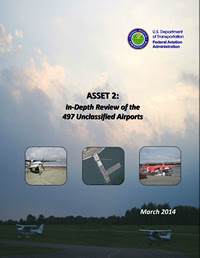 ASSET 2, the FAA’s second study of general aviation (GA) airports was released Thursday. The study provides an in-depth review of the 497 unclassified airports currently in the National Plan of Integrated Airport Systems (NPIAS). The original ASSET study completed in 2012, categorized nearly 3,000 GA airports into four areas: national, regional, local, and basic; defining the vital and diverse roles small airports play in the national air transportation system. However, 497 airports did not fit into a category under the original study.
ASSET 2, the FAA’s second study of general aviation (GA) airports was released Thursday. The study provides an in-depth review of the 497 unclassified airports currently in the National Plan of Integrated Airport Systems (NPIAS). The original ASSET study completed in 2012, categorized nearly 3,000 GA airports into four areas: national, regional, local, and basic; defining the vital and diverse roles small airports play in the national air transportation system. However, 497 airports did not fit into a category under the original study.
In January 2013, the FAA began working with the National Association of State Aviation Officials (NASAO), state aviation offices, airport sponsors and industry stakeholders, to conduct an in-depth review of the unclassified airports to ensure all available information was considered. As a result of that work, the FAA placed 212 airports into one of the four categories. “We really appreciate the opportunity we had to work with the FAA and other stakeholders on ASSET 2 as well as the original study,” said Kim Stevens, Interim President and CEO of NASAO. “These general aviation airports are important to our member states across the country.”
Four of the airports are closed to the public or no longer serve as active airfields and the remaining 281 airports were unable to meet minimum criteria for an existing category. Although the agency could not determine a federal role for these airports, they will remain in the National Plan of Integrated Airport Systems (NPIAS) Plan as unclassified, and the FAA will monitor their activity level and role for possible changes. Ben De Leon, FAA’s Acting Associate Administrator for Airports said they could move quickly should circumstances change for any of the airports. Airports should notify the FAA’s Airport District Office in their region or their respective state aviation office should a change in activity level or role occur that may support a change to their airport category.
The next NPIAS plan will reflect these changed and will be delivered in the fall of 2014.



